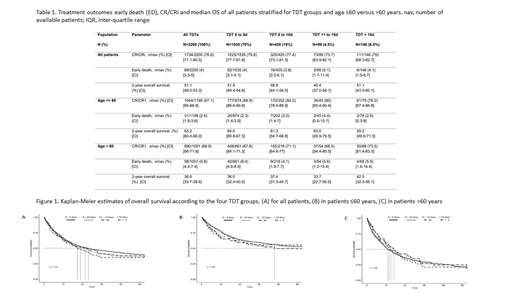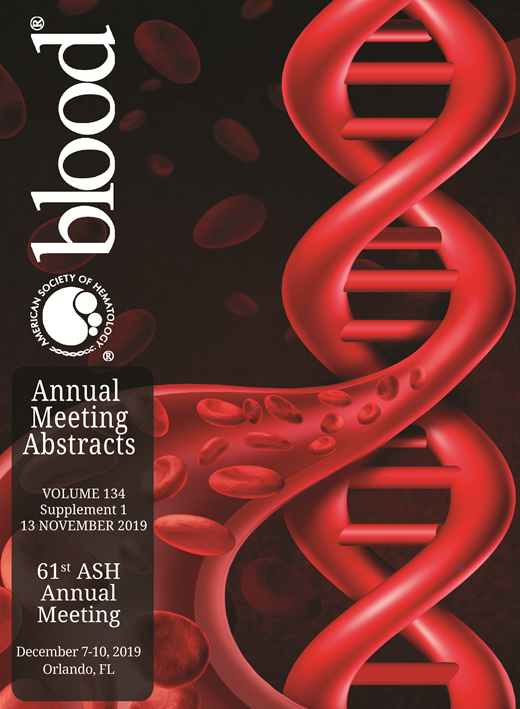
Background
In newly diagnosed acute myeloid leukemia (AML), the general recommendation is to start treatment immediately after the diagnosis has been made. This paradigm is based both on the observation that untreated acute leukemia has a poor prognosis and on retrospective analyses demonstrating a shorter survival in younger AML patients (pts) in whom treatment was delayed by more than 5 days (Sekeres et al., 2009). A more recent single-center analysis came to a different conclusion, showing no prognostic effect for the time from diagnosis to treatment (TDT; Bertoli et al., 2013). We explored the relationship between TDT and prognosis on a large set of real-world data from the AML registry of the Study Alliance Leukemia (SAL) and compared it to the published cohorts.
Methods
The SAL runs a transregional AML registry in 46 treatment centers across Germany (NCT03188874). All registered patients with an intensive induction treatment, a minimum follow-up time of 12 months and no acute promyelocytic leukemia were selected (n=2,200). Treatment start was defined by the first day of cytarabine, whereas single agent hydroxyurea (HU) was labeled as pretreatment. We analyzed the influence of TDT on complete remission (CR), early death (ED) and overall survival (OS) in univariable analyses for each day of treatment delay, in groups of 0-5, 6-10, 11-15 and >15 days of TDT, and by using the restricted cubic spline (RCS) method for data modelling. In order to adjust for the influence of established prognostic variables on the outcomes, we used multivariable regression models and propensity score weighting. The influence of HU pretreatment on outcomes was investigated by introducing an interaction term between TDT and the presence of HU pretreatment.
Results
The median age was 59 years (y) (IQR 50-68), the proportion of pts with favorable, intermediate and adverse genetic risk according to ELN was 27%, 53%, and 20%; >95% of pts received induction treatment with standard 7+3. HU pretreatment was administered in 4% of pts. The median TDT was 3 days (IQR 2-6). Descriptive statistics after grouping of pts showed the highest median age and the lowest proportion of NPM1 mutated and favorable risk in the TDT group 11-15. Of all pts, 79% achieved a CR/CRi; unadjusted CR rates for the patient groups with TDT of 0-5, 6-10, 11-15 and >15 days were 80%, 77%, 74% and 76%, respectively (p=0.317). In multivariable analysis accounting for the influence of ELN risk, age, WBC, LDH, de novo versus secondary AML and ECOG, the OR for each additional day of TDT was 0.99 (95%-CI, 0.97-1.00; p=0.124).
Four percent of pts died within the first 30 days from treatment start. The respective rates in the four TDT categories were 4.0%, 3.8%, 5.1% and 4.1% (p=0.960). In multivariable analysis, the OR for TDT was 1.01 (95%-CI, 0.98-1.05; p=0.549).
After a median follow-up of 40 months, the 2-y OS of all pts was 51%. The unadjusted 2-y OS rates stratified by TDT of 0-5, 6-10, 11-15, >15 days were 52, 49, 46, and 51% (see Table 1 and Figure 1). The hazard ratio (HR) for each day of treatment delay was 1.00 (95%-CI; 0.99-1.01; p=0.317). In multivariable Cox regression analysis, the HR for TDT as continuous variable was 1.00 (95%-CI, 0.99-1.01; p=0.689). When OS was analyzed separately stratified for age ≤60 and >60 ys and for high versus lower initial WBC defined by a threshold of 50 x 109/L, no significant differences between TDT groups were observed.
Multivariable models using TDT as a grouped variable or with RCS did not provide evidence for a significant influence of TDT on outcomes. Propensity score matching of pts in the four TDT groups did not reveal an influence on outcomes. The use of HU was not associated with CR, ED nor OS.
Conclusion
Our study on 2,200 newly diagnosed registry pts receiving consistent intensive induction with standard-dose cytarabine plus daunorubicin (7+3) suggests that TDT is not related to response or survival, neither in younger nor in older pts. Despite multivariable analyses, a bias towards longer TDT intervals in pts judged to be clinically stable by the treating physician cannot be excluded entirely. As treatment stratification in intensive first-line treatment of AML evolves, the TDT data suggests that it may be a safe and reasonable approach to wait for genetic and other laboratory test results in order to assign clinically stable pts to the best available treatment option before the start of intensive treatment.
Krämer:Daiichi-Sankyo: Honoraria, Membership on an entity's Board of Directors or advisory committees; Bayer: Research Funding; BMS: Research Funding; Roche: Consultancy, Honoraria, Membership on an entity's Board of Directors or advisory committees. Hänel:Roche: Honoraria; Amgen: Honoraria; Celgene: Other: advisory board; Novartis: Honoraria; Takeda: Other: advisory board. Jost:Daiichi: Honoraria; Sanofi: Honoraria; Gilead: Other: travel grants; Jazz Pharmaceuticals: Honoraria. Brümmendorf:Merck: Consultancy; Janssen: Consultancy; Novartis: Consultancy, Research Funding; Pfizer: Consultancy, Research Funding; University Hospital of the RWTH Aachen: Employment; Ariad: Consultancy. Krause:Siemens: Research Funding; Takeda: Honoraria; MSD: Honoraria; Gilead: Other: travel; Celgene Corporation: Other: Travel. Scholl:Novartis: Other: Project funding; Pfizer: Other: Advisory boards; Gilead: Other: Project funding; Daiichi Sankyo: Other: Advisory boards; AbbVie: Other: Advisory boards. Hochhaus:Pfizer: Research Funding; Novartis: Research Funding; BMS: Research Funding; Incyte: Research Funding; MSD: Research Funding. Kiani:Novartis: Honoraria, Membership on an entity's Board of Directors or advisory committees, Research Funding, Speakers Bureau. Middeke:Sanofi: Research Funding, Speakers Bureau; Roche: Speakers Bureau; AbbVie: Consultancy, Speakers Bureau; Gilead: Consultancy; Janssen: Consultancy, Speakers Bureau; MSD: Consultancy. Thiede:AgenDix GmbH: Employment, Equity Ownership; Novartis: Research Funding, Speakers Bureau; Bayer: Research Funding; Daiichi-Sankyo: Speakers Bureau. Stoelzel:JAZZ Pharmaceuticals: Consultancy; Neovii: Other: Travel funding; Shire: Consultancy, Other: Travel funding. Platzbecker:Celgene: Consultancy, Honoraria, Research Funding; Abbvie: Consultancy, Honoraria; Novartis: Consultancy, Honoraria, Research Funding.
Author notes
Asterisk with author names denotes non-ASH members.

This icon denotes a clinically relevant abstract


